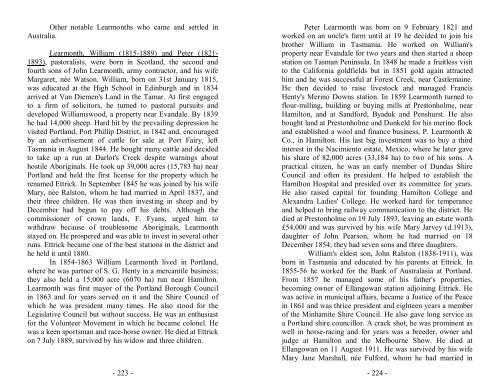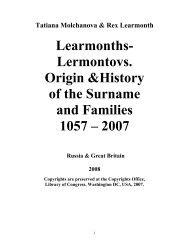LEARMONTH-LERMONTOV. A HYISTORY OF THE NAME AND FAMILIES
By Tatiana Molchanova and Rex Learmonth, 2011
By Tatiana Molchanova and Rex Learmonth, 2011
- No tags were found...
Create successful ePaper yourself
Turn your PDF publications into a flip-book with our unique Google optimized e-Paper software.
Other notable Learmonths who came and settled in<br />
Australia.<br />
Learmonth, William (1815-1889) and Peter (1821-<br />
1893), pastoralists, were born in Scotland, the second and<br />
fourth sons of John Learmonth, army contractor, and his wife<br />
Margaret, née Watson. William, born on 31st January 1815,<br />
was educated at the High School in Edinburgh and in 1834<br />
arrived at Van Diemen's Land in the Tamar. At first engaged<br />
to a firm of solicitors, he turned to pastoral pursuits and<br />
developed Williamswood, a property near Evandale. By 1839<br />
he had 14,000 sheep. Hard hit by the prevailing depression he<br />
visited Portland, Port Phillip District, in 1842 and, encouraged<br />
by an advertisement of cattle for sale at Port Fairy, left<br />
Tasmania in August 1844. He bought many cattle and decided<br />
to take up a run at Darlot's Creek despite warnings about<br />
hostile Aboriginals. He took up 39,000 acres (15,783 ha) near<br />
Portland and held the first license for the property which he<br />
renamed Ettrick. In September 1845 he was joined by his wife<br />
Mary, née Ralston, whom he had married in April 1837, and<br />
their three children. He was then investing in sheep and by<br />
December had begun to pay off his debts. Although the<br />
commissioner of crown lands, F. Fyans, urged him to<br />
withdraw because of troublesome Aboriginals, Learmonth<br />
stayed on. He prospered and was able to invest in several other<br />
runs. Ettrick became one of the best stations in the district and<br />
he held it until 1880.<br />
In 1854-1863 William Learmonth lived in Portland,<br />
where he was partner of S. G. Henty in a mercantile business;<br />
they also held a 15,000 acre (6070 ha) run near Hamilton.<br />
Learmonth was first mayor of the Portland Borough Council<br />
in 1863 and for years served on it and the Shire Council of<br />
which he was president many times. He also stood for the<br />
Legislative Council but without success. He was an enthusiast<br />
for the Volunteer Movement in which he became colonel. He<br />
was a keen sportsman and race-horse owner. He died at Ettrick<br />
on 7 July 1889, survived by his widow and three children.<br />
- 223 -<br />
Peter Learmonth was born on 9 February 1821 and<br />
worked on an uncle's farm until at 19 he decided to join his<br />
brother William in Tasmania. He worked on William's<br />
property near Evandale for two years and then started a sheep<br />
station on Tasman Peninsula. In 1848 he made a fruitless visit<br />
to the California goldfields but in 1851 gold again attracted<br />
him and he was successful at Forest Creek, near Castlemaine.<br />
He then decided to raise livestock and managed Francis<br />
Henty's Merino Downs station. In 1859 Learmonth turned to<br />
flour-milling, building or buying mills at Prestonholme, near<br />
Hamilton, and at Sandford, Byaduk and Penshurst. He also<br />
bought land at Prestonholme and Dunkeld for his merino flock<br />
and established a wool and finance business, P. Learmonth &<br />
Co., in Hamilton. His last big investment was to buy a third<br />
interest in the Nacimiento estate, Mexico, where he later gave<br />
his share of 82,000 acres (33,184 ha) to two of his sons. A<br />
practical citizen, he was an early member of Dundas Shire<br />
Council and often its president. He helped to establish the<br />
Hamilton Hospital and presided over its committee for years.<br />
He also raised capital for founding Hamilton College and<br />
Alexandra Ladies' College. He worked hard for temperance<br />
and helped to bring railway communication to the district. He<br />
died at Prestonholme on 19 July 1893, leaving an estate worth<br />
£54,000 and was survived by his wife Mary Jarvey (d.1913),<br />
daughter of John Pearson, whom he had married on 18<br />
December 1854; they had seven sons and three daughters.<br />
William's eldest son, John Ralston (1838-1911), was<br />
born in Tasmania and educated by his parents at Ettrick. In<br />
1855-56 he worked for the Bank of Australasia at Portland.<br />
From 1857 he managed some of his father's properties,<br />
becoming owner of Ellangowan station adjoining Ettrick. He<br />
was active in municipal affairs, became a Justice of the Peace<br />
in 1861 and was thrice president and eighteen years a member<br />
of the Minhamite Shire Council. He also gave long service as<br />
a Portland shire councillor. A crack shot, he was prominent as<br />
well in horse-racing and for years was a breeder, owner and<br />
judge at Hamilton and the Melbourne Show. He died at<br />
Ellangowan on 11 August 1911. He was survived by his wife<br />
Mary Jane Marshall, née Fulford, whom he had married in<br />
- 224 -






